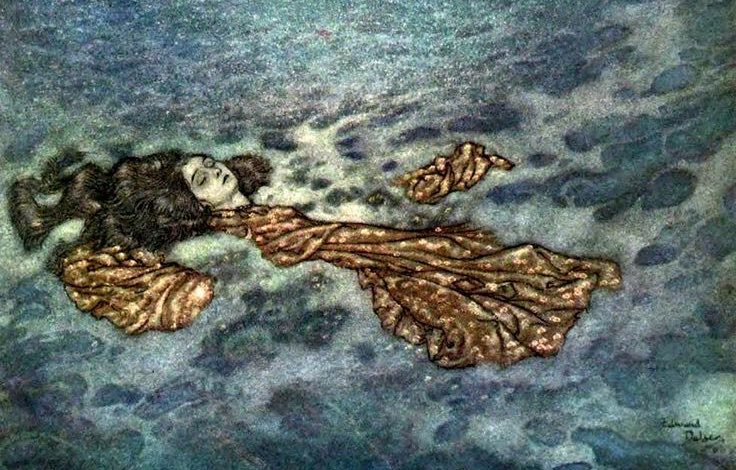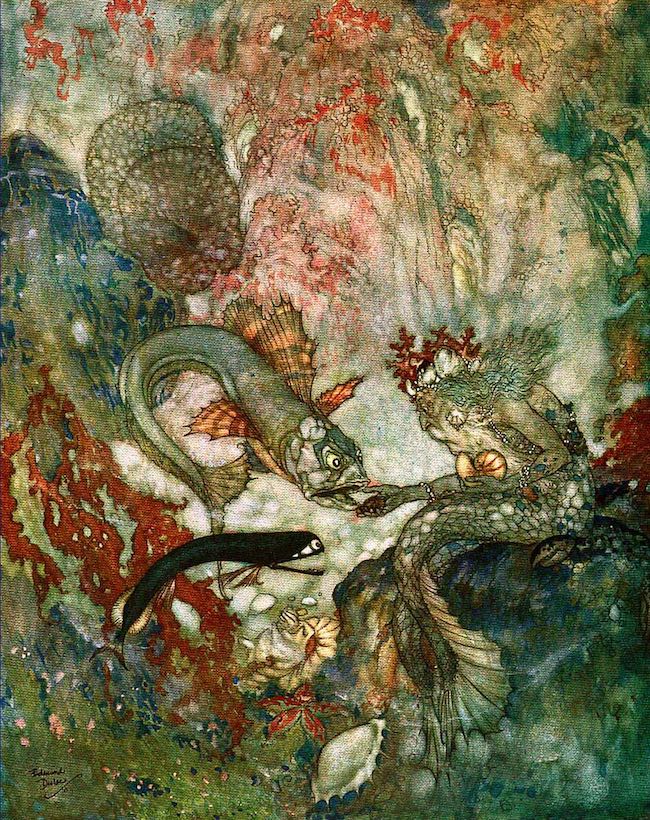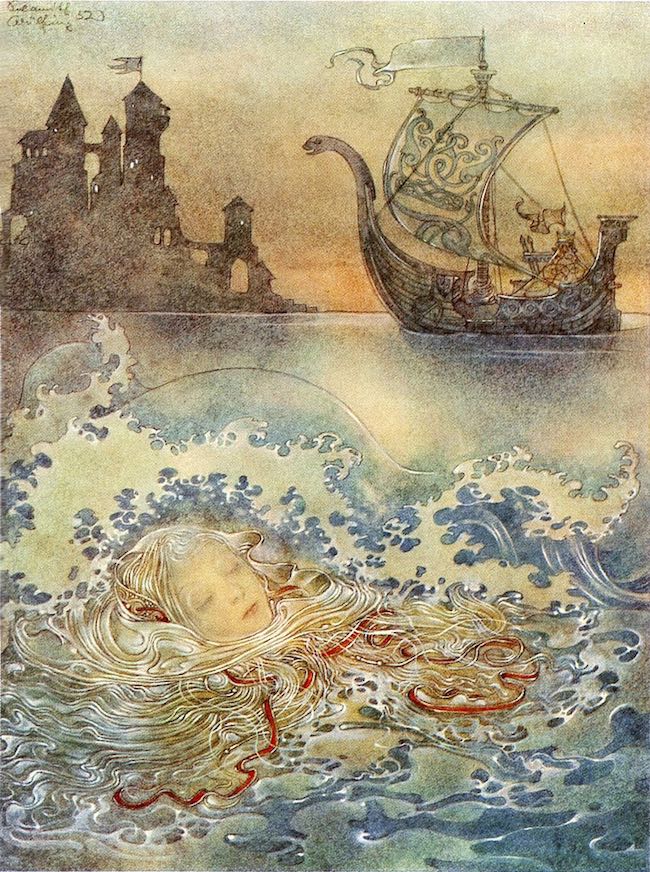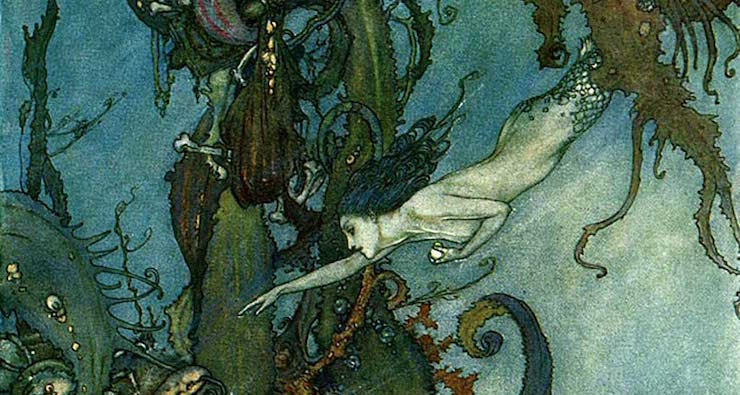“The little mermaid lifted her glorified eyes towards the sun, and felt them, for the first time, filling with tears.”
–The Little Mermaid
I know of few stories that fill reviewers and audiences with as much passion as does The Little Mermaid, originally by Hans Christian Andersen, and later retold by an obscure filmmaker by the name of Walter Disney. If you do a quick internet search for “feminist critique of”, pages of articles will appear that will explain with equal passion why the story is really quite enlightened or terribly retrograde, and why Ariel in the Disney version is either a feminist hero or an anti-feminist villain. You will also find lists comparing the two stories: “eight most significant changes” or “nine terrible truths behind” or “ten most disturbing facts about.”
While reviewers and commentators agree on very little, the one thing most do agree on is that Disney took a fairly sad and depressing fairytale and a relatively reserved main character and “Disney-fied” them both, modernizing the story to give the world a spunky, outgoing little mermaid, and of course a happily-ever-after ending.
Cassandra Stover provides a very well-written critique of The Little Mermaid in the article, “Damsels and Heroines: The Conundrum of the Post-Feminist Disney Princess.” Stover focuses on how Ariel’s behavior shifts so dramatically from before Eric (BE) to after Eric (AE), and it is a fair point. In the Disney version, BE Ariel is strong and independent, and sings, not about love or of finding a man, but about meeting new people and expanding her horizons:
Bet ya on land, they understand,
That they don’t reprimand their daughters—
Bright young women, sick of swimmin’, ready to stand.
A pretty good feminist anthem. Certainly nothing in there about selling your soul and discarding your identity for the merest chance of getting a man you’ve never met before to fall in love with and marry you. AE Ariel, on the other hand, is a very different mermaid. After Eric all of the above is on the table. As Stover writes, “The film reorders her goals much in the way post-feminism reordered American women’s goals.” Meaning that all her dreams are superseded by the need to find true love and a husband.
Stover’s view is not unique, nor will it be the last time the The Little Mermaid is reviewed and written about from this perspective. The constant and conflicting pressures women are placed under by society play out dramatically in Disney’s The Little Mermaid, and the contrast between what Ariel says she wants at the beginning of Disney’s film and what she actually seeks will always be a point of discussion, but it isn’t what I think is the most striking (or, in my mind, most disappointing) thing about the Disney adaptation of Andersen’s story. Rather, I have always had a problem with the “why” Disney gives us for the princess’s reasons for going after her prince.

In Andersen’s version it is true that the little mermaid was attracted to the prince, and sometimes she wondered what it would be like to meet and talk to him, but more than that she longed to be with humans, and to be able to wander the lands above the sea.
Increasingly she grew to like human beings, and more and more she longed to live among them. Their world seemed so much wider than her own, for they could skim over the sea in ships, and mount up into the lofty peaks high over the clouds, and their lands stretched out in woods and fields farther than the eye could see. There was so much she wanted to know. Her sisters could not answer all her questions, so she asked her old grandmother, who knew about the “upper world,” which was what she said was the right name for the countries above the sea.
Up to this point, the two stories agree quite closely. You can almost hear the refrain of Ariel’s song in Andersen’s prose, but what follows could not be more different. Disney’s Ariel is driven to her course by anger at her father and obsession with Prince Eric, as summed up so ably by Ursula:
Now, then. You’re here because you have a thing for this human. This, er, prince fellow. Not that I blame you—he is quite a catch, isn’t he? Well, angelfish, the solution to your problem is simple. The only way to get what you want—is to become a human yourself.
Most people believe that Andersen’s version is, if not identical, at least rooted in the same motivation: the prince. This isn’t actually the case, because the little mermaid of Andersen’s story is seeking something higher: an immortal soul.
“If men aren’t drowned,” the little mermaid asked, “do they live on forever? Don’t they die, as we do down here in the sea?”
“Yes,” the old lady said, “they too must die, and their lifetimes are even shorter than ours. We can live to be three hundred years old, but when we perish we turn into mere foam on the sea, and haven’t even a grave down here among our dear ones. We have no immortal soul, no life hereafter. We are like the green seaweed—once cut down, it never grows again. Human beings, on the contrary, have a soul which lives forever, long after their bodies have turned to clay. It rises through thin air, up to the shining stars. Just as we rise through the water to see the lands on earth, so men rise up to beautiful places unknown, which we shall never see.”
“Why weren’t we given an immortal soul?” the little mermaid sadly asked. “I would gladly give up my three hundred years if I could be a human being only for a day, and later share in that heavenly realm.”
“You must not think about that,” said the old lady. “We fare much more happily and are much better off than the folk up there.”
“Then I must also die and float as foam upon the sea, not hearing the music of the waves, and seeing neither the beautiful flowers nor the red sun! Can’t I do anything at all to win an immortal soul?”

This is the reason that Andersen’s little mermaid is willing to endure the indignity of losing her voice, and the agonies of her transformation, which are so disturbingly and evocatively described by the sea witch “every step you take will feel as if you were treading upon knife blades so sharp that the blood must flow.” It isn’t a young girl’s love fancy, as is frequently believed, or rather not ONLY a young girl’s love fancy, but rather a quest for something greater that drives the little mermaid to seek the sea witch’s help.
Whether you believe in an afterlife or a soul or not, the little mermaid does, and it is this difference in her motivation (although having no real effect on the outcome of the story—the little mermaid still accepts the witch’s Faustian bargain) that makes everything that happens to her more understandable and ultimately acceptable. As much as I love The Little Mermaid’s music and the animation (Sebastian the crab is one of my all-time favorite characters), I have always been troubled by the off-handed manner in which Ariel discards her identity, her family, and potentially her soul for a chance at love with this unknown prince. In making this change Disney inverts the values of the original story. Instead of being about the lengths that the little mermaid will go to in trying to earn a soul and have a chance at heaven, it becomes a story in which her soul hardly enters into it, except insofar as how it might be used as currency to get her want she really wants.
To be clear, I am NOT the biggest fan of Hans Christian Andersen or his stories. At least one commentator has called him “an emotional terrorist” and I mostly agree (if you have ever read the The Little Match Girl or The Red Shoes you will know what I mean). Even in The Little Mermaid, Andersen can’t seem to leave well enough alone and has to add a final warning at the end to make sure that the children listening to the story will be sure to behave themselves:
“This is the way that we shall rise to the kingdom of God, after three hundred years have passed.”
“We may get there even sooner,” one spirit whispered. “Unseen, we fly into the homes of men, where there are children, and for every day on which we find a good child who pleases his parents and deserves their love, God shortens our days of trial. The child does not know when we float through his room, but when we smile at him in approval one year is taken from our three hundred. But if we see a naughty, mischievous child we must shed tears of sorrow, and each tear adds a day to the time of our trial.”
And then the parents are supposed to say, “Good night, sweetheart!”, I suppose.

So, while I am glad that Disney did not simply animate a verbatim version of the Andersen story, I do question some of the choices they made in doing so. In many respects, Andersen’s original little mermaid character is a more liberated person than is Ariel. Unlike Ariel, the Andersen little mermaid is allowed to keep a statue of a handsome human prince (not THE handsome prince, but A handsome prince) openly in her own garden. In the Disney film, King Triton flies into a rage when he finds out about Ariel’s interest in humans, but Andersen’s little mermaid is not only not discouraged or prohibited from finding out about humans, but her sisters actually help her to find him again after the rescue. In fact, all of the mermaid sisters are allowed to go to the surface and explore where and what they will when they reach the age of fifteen.
The role of the sea witch is also altered from the original to the Disney movie. The witch in Andersen’s fairytale is no temptress, but a wise woman that calls the little mermaid’s decision to turn human “foolish.”
“I know exactly what you want,” said the sea witch. “It is very foolish of you, but just the same you shall have your way, for it will bring you to grief, my proud princess. You want to get rid of your fish tail and have two props instead, so that you can walk about like a human creature, and have the young Prince fall in love with you, and win him and an immortal soul besides.”
A lot of people will point to the fact that the original little mermaid dies in the end, and that it is simply too cruel, but that view omits the fact that she actually doesn’t turn to sea foam, but into a spirit of the air.
The sun rose up from the waters. Its beams fell, warm and kindly, upon the chill sea foam, and the little mermaid did not feel the hand of death. In the bright sunlight overhead, she saw hundreds of fair ethereal beings. They were so transparent that through them she could see the ship’s white sails and the red clouds in the sky. Their voices were sheer music, but so spirit-like that no human ear could detect the sound, just as no eye on earth could see their forms. Without wings, they floated as light as the air itself. The little mermaid discovered that she was shaped like them, and that she was gradually rising up out of the foam.

And, why does she turn into a spirit of the air? Because, given the chance to save herself from death by killing the prince, she chooses not to. She sacrifices herself, throwing her chance at salvation to the sea and her life with it.
The little mermaid drew back the crimson curtain of the tent, and beheld the fair bride with her head resting on the prince’s breast. She bent down and kissed his fair brow, then looked at the sky on which the rosy dawn grew brighter and brighter; then she glanced at the sharp knife, and again fixed her eyes on the prince, who whispered the name of his bride in his dreams. She was in his thoughts, and the knife trembled in the hand of the little mermaid: then she flung it far away from her into the waves; the water turned red where it fell, and the drops that spurted up looked like blood. She cast one more lingering, half-fainting glance at the prince, and then threw herself from the ship into the sea, and thought her body was dissolving into foam.
Both the Disney and Andersen versions of The Little Mermaid are about growing up and being willing take risks, but whereas Disney takes the easy way out, Andersen’s story is more subtle, and therefore richer. Andersen’s story tells us that sometimes everyone can do everything right (remember there are no villains in the original fairytale—not even the sea witch) and things can still not work out. When that happens, Andersen concludes, we still have to do the right thing, and sometimes in doing so we get a reward that is unforeseen. Not a bad moral—for an emotional terrorist.
Edmund Dulac artwork from from Stories from Hans Andersen, published by Hodder & Stoughton, 1911.
Sulamith Wülfing artwork from Die Kleine Seejungfrau, published in 1953.
 Jack Heckel is the author of The Charming Tales, including A Fairytale Ending and The Pitchfork of Destiny, which are both available as ebooks and in paperback editions. If you would like to learn more about the author, visit Jack’s website.
Jack Heckel is the author of The Charming Tales, including A Fairytale Ending and The Pitchfork of Destiny, which are both available as ebooks and in paperback editions. If you would like to learn more about the author, visit Jack’s website.










